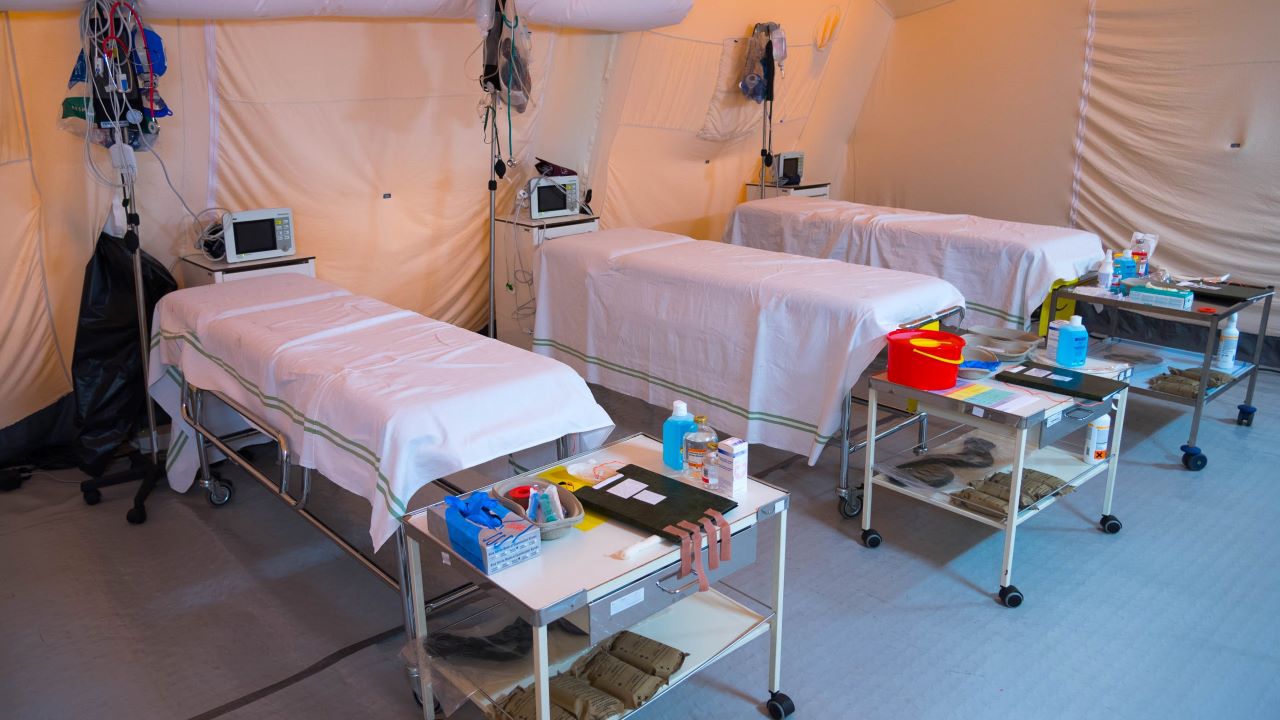
Ask the Experts: What Does It Actually Take to Stand Up a Temporary Hospital, Technologically Speaking?
When the COVID-19 outbreak first began in late 2019, healthcare providers and other first responders in China did not have the luxury of foresight. They didn’t know how this virus would behave, how much of the population was vulnerable and how much of a burden it would ultimately become on even the most prepared healthcare systems. Fortunately, the rest of the world does – at least to a certain extent – and that’s giving many countries an advantage in this fight.
Though several proactive measures are being taken to fortify healthcare capabilities, one of the most prevalent is the construction of mobile hospitals that can either serve as critical-care isolation units for COVID-19 patients or alternative care sites for non-COVID-19 patients.
But, as Zebra’s front-line healthcare team can attest, setting up these temporary acute care facilities is not as simple as moving beds, blankets and supplies into a convention center, tent or other structure. Entire hospitals are being built essentially from the ground up, which means that IT systems, equipment, staff, policies and procedures all have to be considered. (Even triage tents need technology.) So, we’ve asked Zebras who have been working on the front lines with healthcare providers to set up these temporary acute care facilities globally to share their collective learnings in a new series here on the Your Edge blog.
First up is a two-part compilation interview with James Woo, Zebra’s Asia-Pacific (APAC) Healthcare Practice Lead, as well as two of Zebra’s North America Healthcare Account Managers, Kathy Marchant and Katie Johnson.
Your Edge Blog Team: What are the biggest challenges faced by hospitals and other healthcare providers in your region right now?
Kathy: In North America, the first and foremost issue is the lack of personal protective equipment (PPE) and respirators. The second challenge is the excess of patients – those with and without COVID-19 – who urgently need treatment. They must figure out a way to set up remote facilities and start up old hospitals that have been decommissioned in a matter of days or weeks in order to handle the surge in patient volume and, in many cases, to separate COVID-19 patients from others. Of course, in doing all of this, they must think about how they can best protect healthcare workers from being exposed to COVID-19 when interacting with patients and just moving around the facility in general. Therefore, many of the solutions involve a new way of thinking.
As an added challenge, hospitals’ IT departments are having to configure and set up clinical smartphones, scanners, printers and other technologies in tents, convention centers and other off-campus locations while complying with social distancing practices – and without the full on-site support of many of their vendors due to resource limitations. Needless to say, these challenges can slow down the entire process if not properly thought through.
James: APAC is facing many of the same challenges, including insufficient PPE for the front-line staff and a lack of ventilators for intensive care unit (ICU) patients. Our hospitals were also overwhelmed by the sudden surge in patients seeking treatment. China, for example, had no frame of reference in the early stages of the outbreak. It took fast steps to stand up temporary hospitals. At that point in time, there was no way to know for sure if the extra beds would provide enough capacity or if there would be sufficient supplies to sustain a prolonged response. We’re starting to see an uptick in the number of “reactivated” COVID-19 patients here in South Korea: as of April 13, 2020, it was reported that at least 116 people who were cleared of the virus earlier are now testing positive again. The WHO is investigating this report. This resurgence, combined with the number of first-round COVID-19 patients requiring prolonged acute critical care, is creating bed availability issues. It is also contributing to hospital staff fatigue in many countries. Healthcare providers are stretched thin and they’re lacking work-life balance. It’s a tough situation.
Your Edge Blog Team: We know that many different types of temporary medical facilities are being built around the world right now to accommodate the current and anticipated patient influx. Some are already operational with many more scheduled to come online in the next few weeks. Can you tell us a little bit about the projects in each of your regions?
James: They really vary in APAC. For example, there were 19 makeshift hospitals set up in China to add 30,000 beds and equipped with everything from CT scanners and ECG monitors to robots and Internet of Things (IoT) solutions. Whereas, in Singapore, an expo hall is currently being converted into a 500-bed facility for the care of mild COVID-19 cases.
Kathy: The U.S. is very similar in that some of the larger healthcare organizations are adding thousands of beds while others are setting up smaller tents of maybe 100 beds. Some have been set up in a few days, while others have taken a couple of weeks. To be honest, it’s a very fluid situation., and the demands seem to be changing every 24 hours.
Your Edge Blog Team: Are these facilities primarily for COVID-19 patients?
James: In China, the temporary hospitals were primarily used for the treatment of COVID-19 patients with mild symptoms. In Singapore, though, the goal is to transfer two types of patients – recovering COVID-19 patients and those with mild symptoms – in order to free up limited intensive care unit (ICU) and isolation unit beds for new cases.
Kathy: The goal in the U.S. is to facilitate the additional surge of patients and to create areas of isolation.
Your Edge Blog Team: James already mentioned some of the technologies that are being used in these facilities in APAC, but we understand there’s also widespread mobile technology utilization. Kathy – can you talk about that a bit?
Kathy: These tents, convention centers and other temporary facilities are being set up as if the beds were located inside the four walls of a traditional hospital. The only difference is that they’re operating in a limited capacity and, in many cases, don’t have the underlying IT infrastructure in place as you would see with a brick-and-mortar hospital. Think WiFi, workflow systems and the like. That’s where Zebra, our partners and other solution providers are stepping in to help.
Technology remains mission critical to healthcare – arguably more so now that care teams are working off site and trying to coordinate with first responders bringing in patients, triage tents, off-site labs running COVID-19 tests and more. For example, clinical smartphones equipped with voice and text collaboration tools are key to facilitating remote care team communications and dispersing patient information in real time. They also serve as teleconferencing devices between on-site nurses and off-site doctors.
These same clinical smartphones also play a central role in inventory management. Many healthcare systems are still having a hard time managing inventory levels, and care teams are in urgent need of medications and medical supplies like IVs. With a clinical smartphone in hand, they can instantly indicate supply or equipment needs via an app or email to prompt fast replenishment action by those coordinating with the pharmacies and pharmacy distribution centers within the healthcare system.
We’re also seeing many customers ask for patient wristbands or lanyards that would help the nursing staff reduce direct contacts with the patient while still getting the information they need.
Your Edge Blog Team: Are all healthcare systems essentially using the same technologies – and in the same way?
Katie: Not necessarily. I’ve been working with one of the largest not-for-profit healthcare systems in the U.S. to add 4,000 beds across 16 different locations. We worked with them to create point-of-care technology “kits” that include a plethora of clinical smartphones, Bluetooth and tethered barcode scanners, mobile printers, desktop printers and even industrial printers. Though many of the devices are the same standard solutions they would normally use in their permanent hospitals, we did have to dig in a bit to create and configure some specialized solutions given the uniqueness of the COVID-19 care workflows and the physical environment in which they’re being used. We had to be extremely agile. These kits were scoped within days, prepared and shipped to each location and are now being used to enable clinical communications, print and scan patient ID wristbands, print specimen labels, collect and confirm data for electronic health records (EHR) and track testing among other things.
Kathy: Most of the healthcare systems I’ve been working with are using the same technologies that Katie just spoke about, or at least considering the same technologies, but are not necessarily deploying them in a kit-style manner. There isn’t a one-size-fits-all solution here. Some are implementing the exact same IT systems they have inside their traditional hospitals in their alternate care facilities. Others are prioritizing investments in printers for wristbands and specimen labeling. And, in many cases, mobile computers are moving to the top of the list when technology budget becomes available given that they enable real-time communications and coordination between care team members, patients, administrative staff, suppliers and others.
Your Edge Blog Team: James, as a former CIO of a hospital, do you feel as though healthcare systems are taking the right approach to technology utilization in these temporary facilities? Is there anything that they should be paying closer attention to?
James: As Katie noted, healthcare providers want to ensure that they can capture and distribute data to patient traceability systems, the EHR and each other in real time. That’s why you’re seeing the rapid deployment of clinical mobility solutions such smartphones, scanners and tablets in these alternative care facilities. However, mobility solutions require a strong and secure network connection in order to be effective. Given the density of the convention center buildings used in some areas and lack of traditional wireless infrastructure in remote tents, it is critical that WiFi performance be tested and evaluated for its ability to support higher throughput in a secure, consistent manner. Kathy was telling me about a large healthcare organization in the U.S. that has created its own secure network connection with a sort of “Network in a Box” solution for remote sites. That’s one innovative option.
You should also evaluate the antenna technology engineered into the mobile devices chosen for these facilities in case WiFi is not available. Will the devices be able to maintain a consistent 4G connection in areas where traditional consumer devices would experience weak signals? That should be confirmed through site testing or proof of concept before mobile technology selections are finalized.
Tune back in to the Your Edge blog next week to read the rest of our interview with James, Kathy and Katie. You can also learn more about how Zebra is working to empower front-line heroes at www.zebra.com/heroes.

Zebra’s “Your Edge” Blog Team
The “Your Edge” Blog Team is comprised of content curators and editors from Zebra’s Global PR, Thought Leadership and Advocacy team. Our goal is to connect you with the industry experts best-versed on the issues, trends and solutions that impact your business. We will collectively deliver critical news analysis, exclusive insights on the state of your industry, and guidance on how your organization can leverage a number of different proven technology platforms and strategies to capture your edge.




